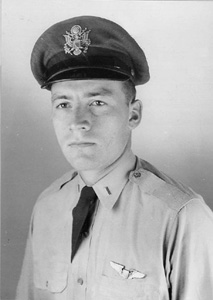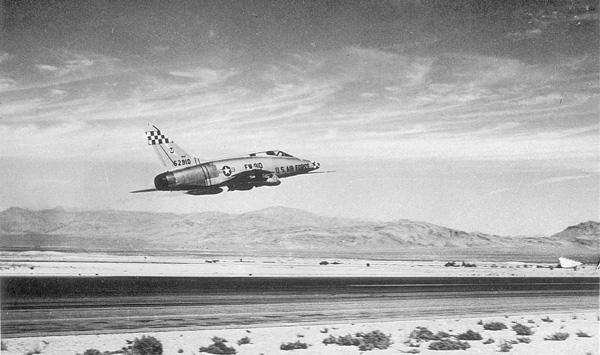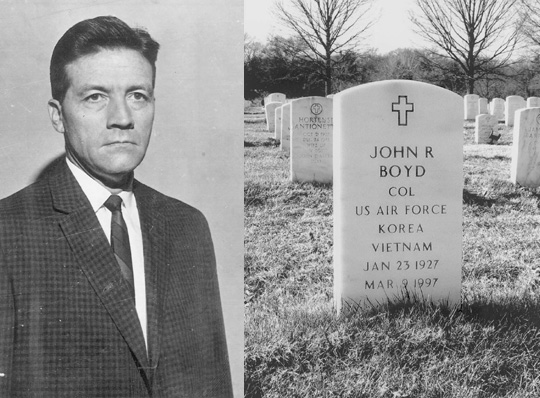| Home Page | John Boyd - USAF
The Fighter Pilot Who Changed the Art of Air Warfare by Robert Coram |
Airmen Index |
|---|---|---|
 |
||
| John Boyd in 1952, after winning his wings as an Air Force pilot. After basic flying instruction in Mississippi, he trained in jets at Williams AFB, then combat training in the F-86 at Nellis AFB, before being sent to Korea. (Boyd Family Photo) | ||
|
During the 1950s, John Boyd dominated fighter aviation in the U.S. Air Force. His fame came on the wings of the quirky and treacherous F-100; the infamous "Hun." Boyd was known throughout the Air Force as "Forty-Second Boyd," because he had a standing offer to all pilots that if they could defeat them in simulated air-to-air combat in under 40 seconds, he would pay them $40. Like any gunslinger with a name and a reputation, he was called out many times. As an instructor at the Fighter Weapons School (FWS) at Nellis AFB, he fought students, cadre pilots, Marine and Navy pilots, and pilots from a dozen countries, who were attending the FWS as part of the Mutual Defense Assistance Pact.
He never lost. Boyd was famous for a maneuver he called "flat-plating the bird." He would be in the defensive position with a challenger tight on his tail, both pulling heavy Gs, when he would suddenly pull the stick full aft, brace his elbows on either side of the cockpit, so the stick would not move laterally, and stomp the rudder. It was as if a manhole cover were sailing through the air and then suddenly flipped 90 degrees. The underside of the fuselage, wings, and horizontal stabilizer became a speed brake that slowed the Hun from 400 knots to 150 knots in seconds. The pursuing pilot was thrown forward and now Boyd was on his tail radioing "Guns. Guns. Guns." The myth of "Forty-Second Boyd" still rankles AF fighter pilots. They say there is no "best" pilot; that everyone has a bad day. But if they went through Nellis in the late 1950s, they know Boyd had no bad days. And they cannot come up with the name of anyone who ever defeated him. Boyd was equally famous in the classroom where he developed the "Aerial Attack Study." Until Boyd came along, fighter pilots thought that air combat was an art rather than a science; that it could never be codified. Boyd proved them wrong when he demonstrated that for every maneuver there is a series of counter maneuvers. And there is a counter to every counter. Afterwards, when fighter pilots attacked (or were attacked), they knew every option open to their adversary and how to respond. |

|
| An F-100 taking off from Nellis AFB circa 1959. Note checkerboard pattern on the vertical stabilizer and nose. This indicates it was a "Hun" from the Fighter Weapons School. It was in the Hun that Boyd became famous as "Forty-Second Boyd," the man who defeated all challengers in simulated air-to-air combat in less than 40 seconds. (USAF Photo) |
|
After the study was declassified, foreign pilots passing through Nellis took it home where it changed the way every air force in the world flies and fights. Even today, more than 40 years later, nothing substantial has been added to the Aerial Attack Study.
After a six-year assignment at Nellis, Boyd returned to college for another undergraduate degree. He went to the Georgia Institute of Technology where, one night while studying for an exam in thermodynamics, he had the epiphany that became his famous Energy-Maneuverability Theory, or E-M Theory, as it came to be known. The E-M Theory changed everything that everyone thought they knew about fighter combat. It enabled fighter pilots to evaluate their energy potential at any altitude and at any maneuver. And, perhaps more importantly, the energy potential of their adversary. It changed forever the way aircraft are fought in combat. Boyd then used E-M as a design tool. Until E-M came along, fighter aircraft had been designed to fly fast in a straight line or fly high to reach enemy bombers. The F-X, which became the F-15, was the first Air Force fighter ever designed with maneuvering specifications. Boyd was the father of the F-15, the F-16, and the F-18. America has dominated the skies for the past 30 years because of John Boyd. After he retired, he developed a theory of combat that, according to Vice President Dick Cheney who was Secretary of Defense at the time, was responsible for America's swift and decisive victory in the Gulf war. |

|
|
| John Boyd after retiring from the Air Force. (Boyd Family Photo) |
John Boyd's grave in Arlington National Cemetery, Section 60, gravesite 3660. He was buried in March, 1997. (Photo by Chet Richards) |
|
But it is as a fighter pilot that many retired Air Force officers today remember John Boyd.
For the past three years I have been researching Boyd's life for a biography titled "Boyd: The Fighter Pilot Who Changed the Art of War." It will be published by Little, Brown and Company in November, 2002. The chapters covering Nellis in the 1950s will be of much interest to fighter pilots. |
© The Aviation History On-Line Museum. 2002 All rights reserved.